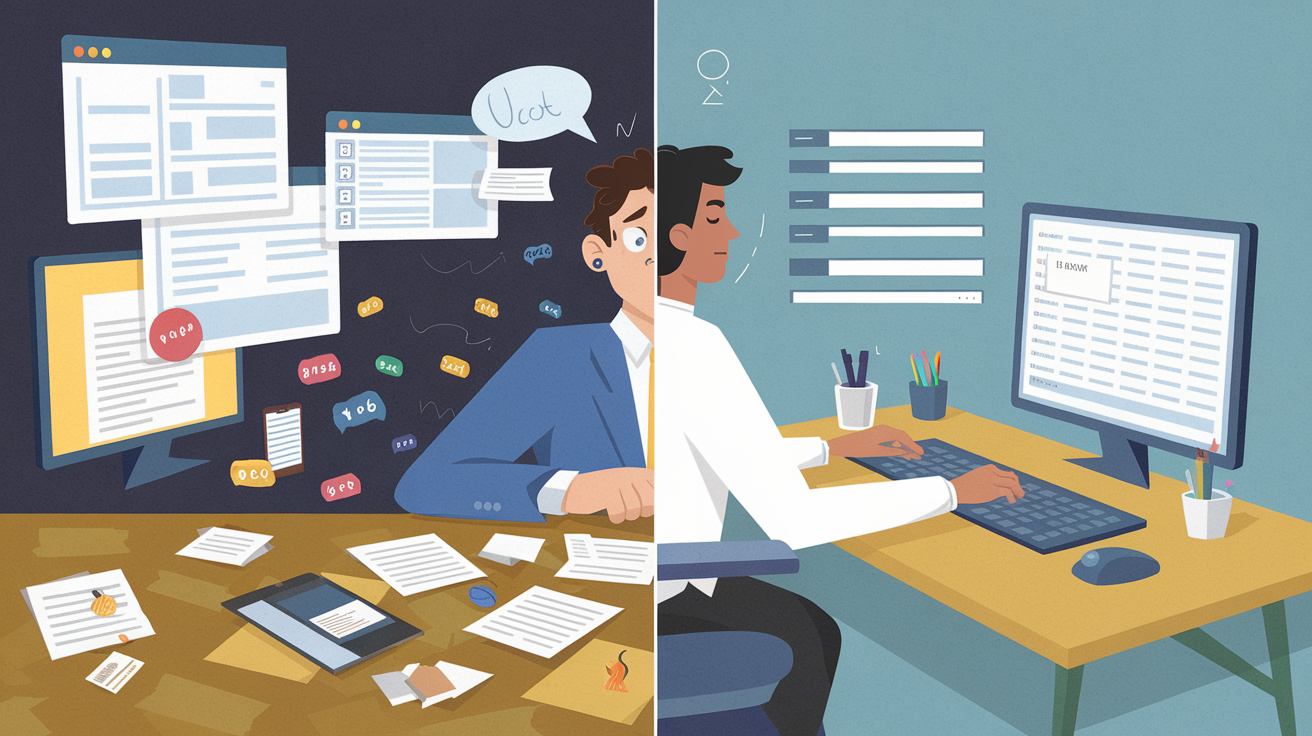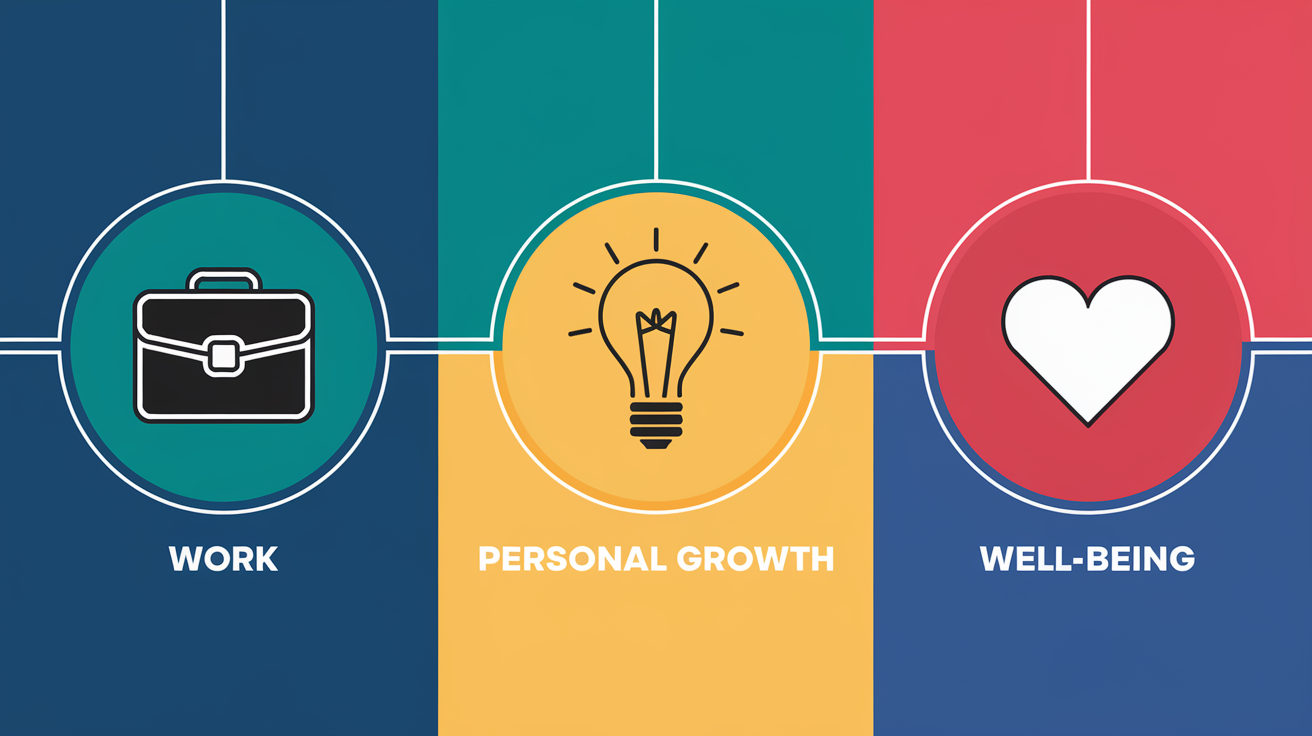No, You Don’t Really Have to Do It All (Try This Instead)
Spoiler alert: You don't need to hustle 24/7 to succeed. In fact, "doing it all" might be the very thing holding you back from real productivity and work-life balance.
If you're feeling overwhelmed by endless to-do lists and multiple commitments, take comfort in the fact that you're not alone. Recent studies show that an astounding 82% of professionals report experiencing burnout, while nearly half of employees admit to being productive less than 75% of the time.
The pressure to juggle multiple projects, maintain a thriving social life, pursue side hustles, and still somehow find time for self-care has become the norm these days.
The pressure to juggle multiple projects, maintain a thriving social life, pursue side hustles, and still somehow find time for self-care has become the norm these days.
We've collectively bought into the myth that being perpetually busy equals being successful. But what if I told you that this approach isn't just unsustainable—it's actually counterproductive?
In this article, we'll debunk the myth of "doing it all" and explore why attempting to tackle everything simultaneously might be the biggest obstacle to your success.
More importantly, I will introduce you to a practical alternative that could transform the way you approach your daily tasks and help you achieve more by doing less.

The Myth of "Doing It All"
Why do we fall into the trap of trying to "doing it all"?
Perhaps it's the constant stream of "productivity porn" on social media. You know, those perfectly curated feeds showing people who seemingly master multiple ventures while maintaining picture-perfect lives. Or maybe it's our innate fear of missing out on opportunities.
Whatever the trigger, this compulsion to juggle everything simultaneously comes at a steep cost.
Recent research reveals that multitasking, often worn as a badge of honor, can actually reduce your productive time by up to 40%. Even more surprising, attempting to handle multiple tasks simultaneously can temporarily lower your IQ by 15 points.
That's right—trying to do everything at once literally makes you less capable of doing anything well.
But the impact goes beyond just productivity.
When we're constantly switching between tasks, our brains must realign themselves every time, leading to increased stress levels and mental fatigue.
This perpetual state of partial attention not only affects our performance but also our emotional intelligence—a crucial factor in both personal and professional success.
By trying to be everywhere and do everything, we end up being nowhere and accomplishing little of significance.
Busy ≠ Productive: The Trap of Modern Hustle Culture
The glorification of "hustle culture" has created a dangerous illusion: that being constantly busy equals being productive. Yet recent studies tell a different story.
Despite the popular narrative that success requires working around the clock, data shows that productivity actually increases by 2.3% when we work smarter, not longer.
Let's talk about what "doing it all" really looks like in practice.
Does this scene sound familiar? Multiple browser tabs open, notifications pinging from various apps, jumping between tasks while trying to maintain the appearance of having everything under control.
This is what we've been conditioned to believe productivity looks like. But here's the reality check: this approach is costing you almost half of your potential productive time.
The truth is, what we often label as "productivity" is actually just organized chaos.
Studies reveal that employees who maintain a balanced approach to work not only report higher job satisfaction but also demonstrate better performance compared to those caught in the endless hustle.
It's a stark contrast to the "rise and grind" mentality that dominates social media feeds and corporate culture.
In reality, organizations that prioritize work-life balance over constant hustle see improved employee creativity, higher motivation, and—perhaps most surprisingly—better long-term goal achievement.
When we stop treating exhaustion as a badge of honor and start viewing balance as a strategic advantage, something remarkable happens: we actually get more done.

The 3-Priority Rule: Focus on What Truly Matters
Instead of spreading yourself thin across dozens of tasks, focus on just three key priorities each day. It's not about doing less – it's about doing what matters most.
This simple yet powerful principle could transform your approach to productivity, and there's fascinating science behind why it works.
Our brains are naturally wired to process information in groups of three. It's not just a coincidence – this cognitive sweet spot helps us create meaningful patterns and maintain focus without feeling overwhelmed.
When we exceed this natural limit, our ability to execute tasks effectively diminishes, leading to that all-too-familiar feeling of spinning our wheels without making real progress.
Here's what makes the 3-Priority Rule so effective: it forces you to be intentional about what truly matters.
Rather than facing a daunting list of twenty tasks (and feeling guilty about the nineteen you didn't complete), you concentrate your energy on three meaningful priorities that will actually move the needle.
Research shows that people who limit their daily priorities are not only more likely to complete their tasks but also report higher levels of satisfaction and reduced stress.
Think of it like this: if you were given three arrows to hit a target, would you shoot them all haphazardly at once, hoping one might hit? Or would you take careful aim with each arrow, maximizing your chances of success?
The 3-Priority Rule applies this same logic to your daily tasks. By giving each priority your focused attention, you're more likely to achieve meaningful results rather than scattered progress across multiple fronts.

Case Study: How Simplification Led to Success
Let me tell you about Sarah, one of my students from a recent productivity workshop. When Sarah first joined my class, she was the epitome of "doing it all."
As a talented graphic designer, she had a full-time agency position, managed three regular freelance clients, was developing an online course about brand identity, and was trying to build her social media presence—all while being a present parent to two young children.
On paper, she was living the dream of a modern creative professional. In reality, she was burning out fast.
"I thought being successful meant saying yes to every opportunity," she shared during one of our sessions. "Each project seemed too good to pass up, but I was delivering at 70% of my potential across the board because my energy was so divided."
After implementing the 3-Priority Rule, Sarah made some bold decisions. She focused on three key areas: her highest-paying freelance client, her course development (but at a measured pace), and dedicated family time.
The results? Within three months, she reported:
- A 40% increase in revenue despite having fewer clients, because she could deliver higher-quality work that commanded better rates
- Steady progress on her course, with two modules completed and tested
- Regular family dinners and weekend activities that didn't get canceled due to work emergencies
"The most surprising thing," Sarah told me in our follow-up session, "wasn't just that I got more done—it's that I finally felt in control of my time rather than being controlled by my to-do list."
Overcoming Common Roadblocks
Let's talk about what really stops people from implementing the 3-Priority Rule. Not the excuses we tell ourselves, but the actual obstacles that show up day after day.
Here are the most common roadblocks, according to recent research:
- The daily paralysis of choosing priorities
- The mental drain from multitasking
- The pressure of workplace expectations
- The challenge of work-life boundaries (67% cite flexibility as crucial for managing responsibilities)
- The overwhelm from constant connectivity
- The difficulty of maintaining sustainable habits (Data shows working beyond 49 hours per week leads to decreased productivity)
The thing is, these obstacles aren't unique to you. They're universal challenges that every person faces when trying to do less but better.
The solution isn't complex, but it requires a shift in mindset. Instead of trying to manage everything, manage your attention.
Here's how:
When you feel guilty about unfinished tasks, remember that your to-do list is a catalog of possibilities, not a contract. Every time you choose a priority, you're not just selecting what to do – you're choosing what not to do right now.
When others demand your attention, use this script:
"I can help you with that tomorrow. Right now, I'm focused on completing [priority task]."
Direct, professional, and clear. Most people will respect boundaries when you set them consistently.
The key is to make these solutions systematic. Don't rely on willpower. Create a simple checklist for selecting your daily three priorities. Set specific times to check email and messages. Block your calendar for focused work.

Conclusion: Small Steps, Big Wins
The myth of "doing it all" isn't just wrong – it's dangerous. It's the story that keeps talented people stuck in the cycle of constant motion without meaningful progress. It's the lie that burns out 82% of professionals while convincing them they're just not working hard enough.
But now you know better.
You understand that true productivity isn't about doing more but about doing what matters.
The 3-Priority Rule isn't just another productivity hack. It's a fundamental shift in how you approach your daily choices.
And with TaskSpur, implementing this rule becomes seamlessly intuitive.
Here's how to put the 3-Priority Rule into action using TaskSpur:
1. Start each morning with the "Plan My Day" feature in TaskSpur
2. From your task list, select your top three priorities for the day
3. Let Ari, your AI assistant, help organize the rest of your tasks around these core priorities
4. Use TaskSpur's goal-tracking dashboard to see how focusing on key priorities accelerates your progress
A year from now, you won't remember most of the tasks on today's to-do list. But you will remember the important projects you completed, the relationships you nurtured, and the goals you achieved. These are the results of focused, intentional choices.
So choose with intention.
Til the next blog.
References
- 39 Workplace Statistics to shape your people Strategy in 2025. (n.d.). https://www.deel.com/blog/workplace-statistics/
- Borja, C., & Borja, C. (2025, January 2). Workplace productivity statistics (2024 update). Time Doctor Blog. https://www.timedoctor.com/blog/workplace-productivity-statistics
- Impact of COVID-19 on Work-Life Balance: Benefits & challenges. (n.d.). https://essaypro.com/blog/impact-of-covid-19-on-work-life-balance
- Multitasking: Switching costs. (2006, March 20). https://www.apa.org. https://www.apa.org/topics/research/multitasking
- Productivity up 2.3 percent in 2024. (2025, February 12). Bureau of Labor Statistics. https://www.bls.gov/opub/ted/2025/productivity-up-2-3-percent-in-2024.htm
- Demartini, J. (n.d.). The Psychology of Priority - DeMartini blog. https://drdemartini.com/blog/psychology-of-priority
- A circular relationship between productivity and hours worked. (2024, March 29). CEPR. https://cepr.org/voxeu/columns/circular-relationship-between-productivity-and-hours-worked